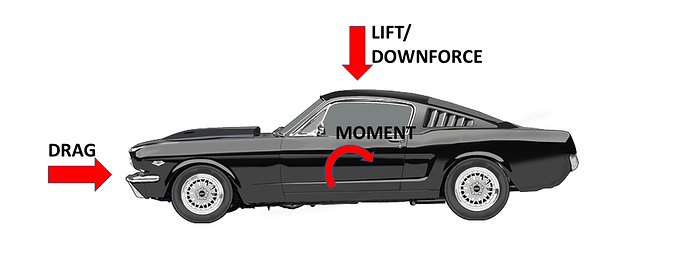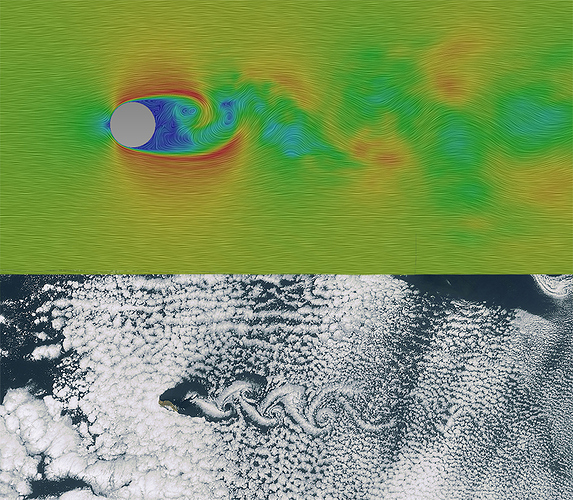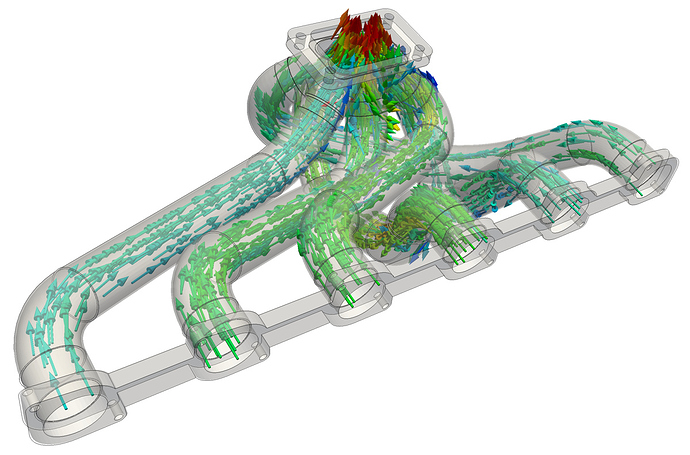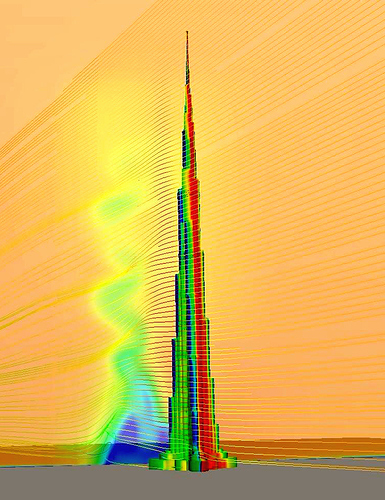pictures will be smaller in documentation. just didn’t want to calculate the new ratio in the forum.
Aerodynamics is the science of moving air and its impact on solid bodies placed in the flow field as an obstacle. Being a sub-field, most of the equations from fluid dynamics apply to aerodynamics as well, including all the governing equations, turbulence, boundary layer theory, and ideal gas assumption.
History
Although wind had been widely used as a tool by humankind (windmills, sailboats) already, the beginning of the scientific study of aerodynamics only dates back to the seventeenth century. The dream of flight and a machine that is “lighter than air” was already present in ancient history. Very early attempts to describe flow quantities appear in the work of Aristotle and Archimedes, however the scientific field “aerodynamics” does not appear in their notes.
The very first aerodynamicist was Sir Isaac Newton, who developed and described the theory of flow resistance, also known as drag. Further famous scientists such as Bernoulli, Euler, Navier, and Stokes gave more precise and mathematically founded description about gas dynamics. The famous Navier-Stokes governing equations of fluid dynamics were born in 1800, however this is also the most difficult model to solve.
The desire for flight was always the main driving force behind the development of the engineering field of aerodynamics. In the early 1800’s, engineers and scientists studied the aerodynamic forces of flight. Terms like “drag”, “lift”, and “thrust” were born and the relationships between them were determined. In 1871, the first wind tunnel was built. Drag theories by engineers like Kirchhoff and Rayleigh were established. Otto Lilienthal was the first person to become successful with glider flights, and after all this research work, the Wright brothers flew for the first time with an engine powered airplane in 1903.
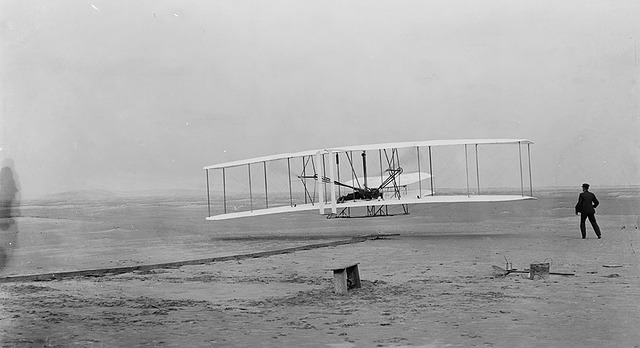
Figure 1: A double decker airplane in the early days of aircrafts
But the study of aerodynamics around airfoils did not stop here. Lanchester, Kutta, Zhukovsky, and Prandtl developed theories to better describe flow circulation around wings. While the First and the Second World Wars boosted the development of aircraft and the science of aerodynamics, the next breakthrough happened in 1947, when the sound barrier was broken for the first time with a Bell X-1 rocket-powered aircraft. At this point, the understanding of subsonic and supersonic flows had matured, however the evolution did not stop here. With the appearance of computers, the numerical calculation of the governing equations became possible. Computational Fluid Dynamics models and software started to appear on the horizon. Nowadays, CFD is utilized in almost every development process where airflow is involved and plays an important role.
Flow classification and equations
An aerodynamic flow field can be classified based on the following physical parameters: velocity, pressure, and temperature. Additionally, density and viscosity can be used as well for classification.
The most common flow classification practices are velocity and pressure-based.
Velocity-based classification
Subsonic flows are flow fields in which the air speed does not exceed the local speed of sound, that is M<1. Typical examples are common ground vehicles like cars, trains, F1 cars, and sport airplanes. M represents the Mach number which is the flow velocity past a boundary. For more information about the mach number, please read our article about incompressible flow.
Transonic flows include both subsonic and supersonic flow regimes 0.8<M<1.2. Typically, commercial airplanes fly in this speed region. A supersonic flow zone appears when the otherwise subsonic fluid accelerates above sound speed due to surface curvatures (e.g. suction side of the wing).
Supersonic flows are defined as having velocities greater than the speed of sound everywhere in the domain (M>1). Military jets and gun bullets are good examples for this velocity.
We could also include hypersonic flows, where the speed is much higher than the speed of sound. There is no accurate definition of this value (M>>1). Some hypersonic rocket-powered airplanes and spacecrafts can be mentioned as examples.
Density / Pressure-based classification
Incompressible flow refers to a flow where the material (air) density remains constant. Under Mach 0.3 this is a good assumption for industrial flows and helps engineers make the calculation / simulation simpler. Please note that an incompressible flow does not mean that the fluid has to be incompressible itself.
A flow can be considered as compressible if the density changes along a streamline. Generally, this is the case for subsonic flows above Mach 0.3. Transonic, supersonic, and hypersonic flows are all compressible.
Figure 2: Velocity and Compressibility of flows
Aerodynamic quantities
As mentioned before, aerodynamics is the study of forces on a solid body placed in an airflow. In order to better describe and understand these effects as well as to be able to compare cases easier, one can use mathematical quantities. These parameters include drag, lift, moment, center of pressure and pressure coefficient, to name a few important ones.
Drag
One of the most important quantity in aerodynamics is the resistance of the fluid, also known as drag or drag force. This force is acting opposite to the motion of the solid body relative to the air thus causing losses. This drag force depends on the relative velocity as well as on the shape of the solid body.
The drag force can be computed using the following equation:
where
- {\displaystyle F_{d}} is the drag force,
- {\displaystyle \rho } is the density of the fluid,
- {\displaystyle v} is the speed of the object relative to the fluid,
- {\displaystyle A} is the cross-sectional area, and
- {\displaystyle c_{d}} is the drag coefficient which is dependent on the shape of the object and the Reynolds number.
Lift
Another component of the resulting force on a solid body is called lift or lift force. This component is perpendicular to the oncoming flow direction. The term “lift” is coming from the aeronautics field, where it is an important quantity that makes flying actually possible for objects heavier than air. But lift force is generated in case of propellers, helicopter rotors and even on car bodies and wind turbines. Usually, an asymmetric body or a symmetric body with an angle of attack produces lift force. Lift can be determined by the following equation:
where
- L is lift force,
- ρ is air density,
- v is speed,
- S is the area, and
- {\displaystyle C_{L}} is the lift coefficient
Moment
Aerodynamic moment or torque is produced by the aerodynamic force on a body (wing, car on any solid) making it rotate in the flow field. The rotation happens when this turning force is acting outside the center of pressure or the aerodynamic center.
Figure 3: Aerodynamic quantities on a car
If you imagine the air stream going from the front of the car over the engine hood, you can imagine that the air wants to lift the car at about the point where the headlights are. This is where the moment illustrated in figure 3 is generated.
Center of Pressure
The Center of Pressure (CP) is a point where the force generated by the total sum of the surface pressure acts. This force can be calculated as the surface integral of the vectorial pressure field, and can be used to calculate the stability of an aerodynamic body (bullets, wings, cars). For example, when analyzing a weapon’s bullet aerodynamics, the distance between the CP and the center of gravity can create a rotating moment thus making the projectile less accurate.
Easily speaking you can imagine the Center of Pressure as something like the center of gravity where the average weight of an object is. The center of gravity of a hammer for example is far away from the middle because the handle is usually a lot lighter than the head. The same goes for aerodynamics. The Center of Pressure is the point where the average aerodynamic forces drag and lift/downforce exert. The center of Pressure allows for example engineers to balance the lift of an aircraft.
Pressure Coefficient
One of the most widely used non-dimensional numbers to visualize pressure on the surface of the aerodynamic body is the pressure coefficient C_p. This quantity describes the relative pressures in an incompressible flow, and can be calculated as
where
- p is the static pressure at the location where pressure coefficient is calculated,
- p_{\infty } is the static pressure in the free stream,
- p_{0} is the total pressure in the free stream,
- \rho _{\infty } is the free stream fluid density,
- V_{\infty } is the free stream velocity of the fluid, or the velocity of the body through the fluid.
It can be seen that using C_p, different scenarios of flow / body velocities, pressures and densities can be compared for the same geometry. C_p visualization is broadly used in the automotive industry where different study concepts are compared to each other in a virtual wind tunnel.
Boundary Layer
In aerodynamics, the description, measurement, and simulation of near wall velocity and other quantities are always a challenge. As the flow decelerates rapidly near a solid wall, the viscosity effects become significant in a thin region also known as boundary layer. Boundary layers are classified into two main groups: laminar boundary layers at low Re numbers and turbulent boundary layers at higher flow speeds.
Link to the reynolds number page here! investigate Banner option!
Turbulence
Turbulence plays a very significant role in aerodynamics. Turbulence is by nature a chaotic, irregular phenomena observed in lower viscosity fluids. In general, unsteady vortices appear in many sizes in the flow field and interact with each other and the solid body which usually generates them. Turbulence can be “good” when, for example, one wants to generate thinner boundary layers and “bad”, when it leads to large separations, therefore increased drag and losses. Describing and simulating turbulence is still an ongoing project, however many modeling approaches exist. In CFD, to achieve accurate aerodynamic results, turbulence needs to be taken into account properly. This can be done by either modeling it or resolving the eddies (LES, DES).
Eddies are swirls in a fluid flow regime that create reverse current.
Figure 4: Eddies in a simulation of a cylinder standing in a fluid flow and a real life example of an island creating eddies in the clouds.
Convergence
As mentioned before, the aerodynamic quantities such as drag and lift are the key outcomes of a simulation. Therefore, their convergence to a steady or quasi-steady state is to be monitored and evaluated carefully before the residual targets are reached. When the simulation is stopped too early, the lift and drag values may not be fully converged, resulting in an inaccurate result. Faster convergence and shorter simulation time can be reached by using higher relaxation factors as well as by proper initialization.
Further information about convergence in numerical simulations can be found in this article.
Applications
Aerodynamics is present and plays an important role in almost all the transportation devices and big structures we have around.
Aerospace
As described in the History section, the first studies about aerodynamics appeared with the desire of flight. Later on, the aerospace industry and its continuous research and development on aircraft required many mathematical models, measurement devices, wind tunnels and so on, all designed to understand aerodynamics better. Nowadays it is a key field of studies to reduce emissions, reduce environmental noise and improve human comfort. The terms lift, drag, and moment commonly appear in the design process of an aircraft.
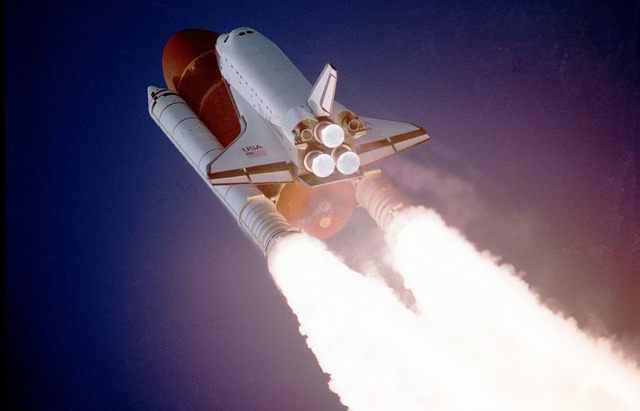
Figure 5: Aerodynamics in Aerospace
Automotive
The automotive industry is very competitive these days. With the desire to build environmentally friendly or even zero emission vehicles, the reduction of drag is a key aspect of the development process. Brake cooling and HVAC airflow can also be mentioned here as some of the main topics of aerodynamics. The importance of lift force appears mostly when studying stability and when designing race vehicles.
Sports
With the continuous improvement of performance in sports, the aerodynamics of race bikes, swimmers, motorbikes, or Formula 1 cars is becoming more and more important. In a competition, where even milliseconds count, the reduction of the drag by 0.1% can distinguish the winner from the others. Modern CFD tools allow the engineers to simulate tiny to extremely large scale bodies in many different scenarios.

Figure 6: Aerodynamics play an important role in speed biking
Internal flows: HVAC and ductwork
Aerodynamics in HVAC (Heating, Ventilation and Air Conditioning) and pipe flow applications are also important. Here usually pressure losses are calculated as a result of viscous aerodynamic forces, separation at corners and bendings and sudden expansions.
Figure 7: Piping work at the manifold of an engine
Wind load on buildings and urban aerodynamics
In case of tall buildings and skyscrapers, due to their large surface area, forces due to wind loads can be quite significant. This can be handled as “drag” force of the solid obstacle placed in the flow. Besides the wind load force on the structure, pedestrian comfort can be also assessed at lower levels. Separations on the structure as well as high speed regions can affect humans, making it sometimes impossible to even walk. Building and urban aerodynamicists simulate those scenarios with CFD tools these days.
Figure 8: Simulation of Burj Kalifa to determine wind loads
Wind turbine
A very important technology towards sustainable energy resources is the wind turbine. As it usually consists of 3 aerofoils placed in an airflow, all the aspects of aerodynamics are present. Drag is used as a measure of the efficiency of the turbine, and lift as a measure of the power extracted from the wind. Moments are used to calculate the loads on the blades.
SimScale provides a very interesting Project Spotlight about the optimization of wind turbine blades. Go and check it out if you are interested in finding out more about this interesting topic.
Hydrodynamics
As a very similar field to aerodynamics, hydrodynamics needs to be mentioned here as well. Hydrodynamics deals with liquid flows, mostly water. While usually incompressible and low speed, water flows experience the same effects as air flow scenarios: boundary layers, turbulence, and forces acting on a solid body are also present.
Aerodynamics and SimScale
Most of the transient or steady, compressible or incompressible aerodynamic flows can be accurately simulated with CFD software. SimScale offers a browser-based platform for engineers, where a CAD design can be meshed and simulated, and the results post-processed easily. Additionally, you can have a look at the Public Projects and choose a case which fits your problem best, so you can get started even faster.
Animation 1: Aerodynamic simulation of a football performed with SimScale
insert banner here
Resources
von Karman, Theodore (2004). Aerodynamics: Selected Topics in the Light of Their Historical Development. Dover Publications. ISBN 0-486-43485-0. OCLC 53900531
Anderson, John D. (1997). A History of Aerodynamics: And Its Impact on Flying Machines. Cambridge University Press. ISBN 0-521-45435-2. OCLC 228667184.
Anderson, John D. (2007). Fundamentals of Aerodynamics (4th ed.). McGraw-Hill. ISBN 0-07-125408-0. OCLC 60589123.



